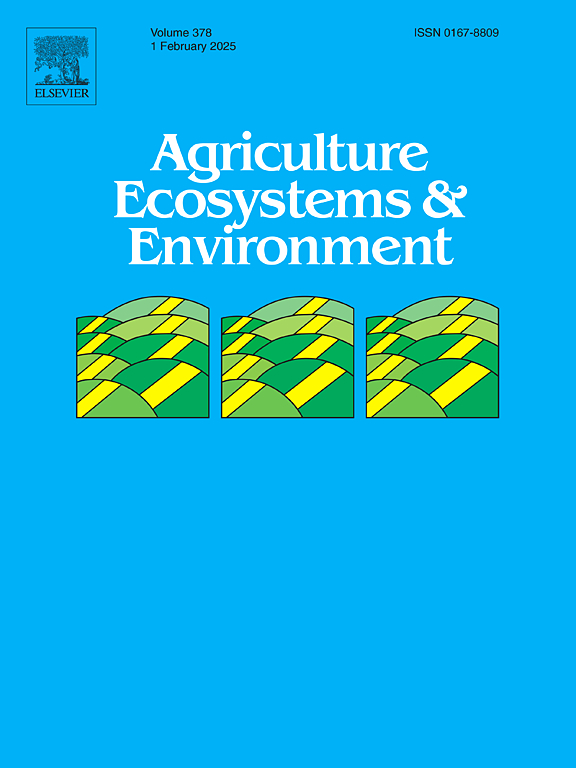给牛喂食含有柳叶的水杨酸盐可以调节尿素代谢,减轻土壤中尿源性氨和氧化亚氮的排放
IF 6
1区 农林科学
Q1 AGRICULTURE, MULTIDISCIPLINARY
引用次数: 0
摘要
放牧地的反刍动物对畜牧业生产中氨(NH3)和氧化亚氮(N2O)的排放有很大影响。柳叶是反刍动物营养的补充,富含水杨酸盐和单宁,可能对NH3和N2O的排放有缓解作用。我们假设牛营养中添加柳叶会影响氮和尿素代谢,并减轻土壤中尿NH3和N2O的排放。8头断奶荷斯坦公牛犊牛在牧场饲养,并在交叉设计中补充柳叶或苜蓿干草。在呼吸室中,记录采食量、粪便和尿液排泄,并分析总氮和氮代谢物。尿素- n循环是通过静脉注射13C尿素示踪剂和一系列血液采样来测量的。用添加不同水杨酸盐的牛尿和人工模拟物与标准土壤孵育,测定NH3、N2O和N、O同位素特征。尽管饲粮中添加柳叶降低了尿素周转率和氮消化率,但对微生物蛋白质合成和生长速率没有影响。饲喂柳叶的牛尿液中尿素减少,但马尿酸、酚酸和水杨酸浓度增加,这主要抑制了土壤中N2O释放的细菌反硝化过程,并分别减少了14%和81% %的NH3和N2O排放。这些结果强调了确定牧场中添加柳叶的牛的营养意义和减排潜力的内在和外在机制。本文章由计算机程序翻译,如有差异,请以英文原文为准。
Feeding salicylates containing willow leaves to cattle modulates urea metabolism and mitigates urine-derived ammonia and nitrous oxide emissions from soil
Ruminants on grazing lands have a great impact on ammonia (NH3) and nitrous oxide (N2O) emissions released from livestock production. Willow leaves are an established supplement in ruminant nutrition and are rich in salicylates and tannins, which may have a mitigating effect on NH3 and N2O emissions. We hypothesised that willow leaf supplementation in cattle nutrition affects nitrogen (N) and urea metabolism and mitigates urinary NH3 and N2O emissions from soil. Eight weaned Holstein bull calves were kept on pasture and supplemented with willow leaves or alfalfa hay in a crossover design. In a respiration chamber, feed intake, faeces and urine excretions were recorded and analysed for total N and N-metabolites. Urea-N recycling was measured by the intravenous administration of a 13C urea tracer and a series of blood sampling. Cattle urine and artificial mimics supplemented with different salicylates were incubated with standard soil to measure NH3 and N2O and the N and O isotopic signatures. Despite a decline in urea turnover and N digestibility in rations supplemented with willow leaves, the leaves had no effect on microbial protein synthesis or the growth rate. Urine excretions with reduced urea but increased hippuric acid, phenolic acids, and salicylate concentrations in cattle fed willow leaves mainly inhibited bacterial denitrification processes involved in N2O release from soil and mitigated NH3 and N2O emissions by 14 and 81 %, respectively. The results highlight intrinsic and extrinsic mechanisms that define both the nutritional significance and emission mitigation potential of supplementing cattle in pastures with willow leaves.
求助全文
通过发布文献求助,成功后即可免费获取论文全文。
去求助
来源期刊

Agriculture, Ecosystems & Environment
环境科学-环境科学
CiteScore
11.70
自引率
9.10%
发文量
392
审稿时长
26 days
期刊介绍:
Agriculture, Ecosystems and Environment publishes scientific articles dealing with the interface between agroecosystems and the natural environment, specifically how agriculture influences the environment and how changes in that environment impact agroecosystems. Preference is given to papers from experimental and observational research at the field, system or landscape level, from studies that enhance our understanding of processes using data-based biophysical modelling, and papers that bridge scientific disciplines and integrate knowledge. All papers should be placed in an international or wide comparative context.
 求助内容:
求助内容: 应助结果提醒方式:
应助结果提醒方式:


